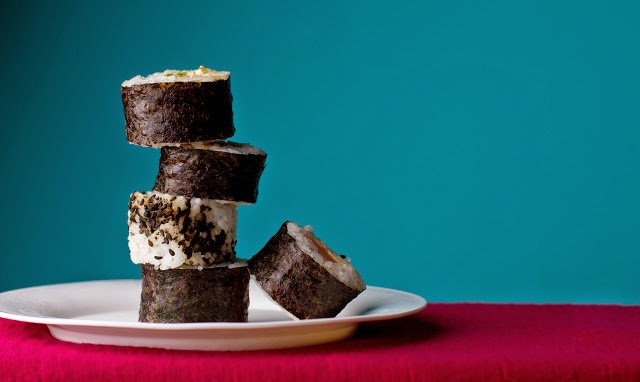So if you’re looking to broaden your culinary skills, add a new meal to your health and fitness diet, or simply wanting something fun to do on ‘date night,’ why not try making your own homemade sushi....
1. Types of Sushi
- Futumaki – larger tubes, typically containing two or three different fillings
- Hosomaki – thinner tubes, usually containing a single filling
2. What you will need to make sushi
- a bamboo mat
- nori (flat sheets of toasted seaweed)
- fillings
- sushi rice
In terms of the filling, good vegetables to use include cucumber, grated carrots, asparagus, pepper and spring onion. In terms of fish, sashimi tuna is a popular choice, as is smoked salmon and crab meat. But as always, experiment with a range of different options, until you discover your own favourite mix.
3. How to make the sushi rice
Prepare the rice a couple of hours beforehand, as it can only be used in the sushi once it has cooled down to room temperature. But before you go reaching for that trusty ol’ glass jar, unfortunately, it has to be a particular sort of rice...
Sushi rice, traditionally known as sushi-meshi, is available in most supermarkets (it looks like normal rice, only shorter and rounder), and is prepared in a certain way to ensure it stays sticky and subsequently, intact.
Begin the process by following the simple directions on the packet. At this point, it’s pretty similar to normal rice. But once cooked, it’s time to add the secret ingredients that gives it that lovely, sticky consistency, as well as that particular ‘oriental’ flavour.
For one and a half cups of uncooked rice, mix a quarter cup of rice wine vinegar with a tablespoon of sugar and a tablespoon of salt, and stir the mixture in. Voila!
4. Preparing the sushi fillings
- First things first, place the nori ‘rough side up’ on the bamboo mat.
- Spread the rice evenly over the nori, keeping a gap of approximately 2cm from the edge for sealing purposes
- Whatever fillings you decide on, cut the ingredients into long, similarly sized strips, and add them in a line measuring roughly 3-4cm across, down one side of the nori.
5. How to roll the sushi wrap
Now it’s time for what is arguably the most difficult step of the entire process; the rolling! Use the flexible bamboo mat to starts things off, and then continue rolling the seaweed, ensuring that you apply a consistent level of pressure throughout. Wet the remaining exposed edge of the nori, and use that to seal the deal.
Now cut the wrap using a wet, sharp knife. For evenly sized sections, it’s easiest to cut into eight, as you can start by cutting the tube into half, and then into half again, and so on.
Lastly, serve with soy sauce, wasabi, and pickled ginger, and toast your success with a cup of saki; Kanpai!
Title Image Credits - Luciano Meirelles
















0993F44374
ReplyDeletetakipçi satın al
Başkasına Takipçi Gönderme
Bitlo Güvenilir mi
Instagram Takipçi Kasma
Instagram Takipçi Arttırma